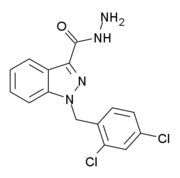Adjudin
Adjudin (AF-2364) is a drug which is under development as a potential non-hormonal male contraceptive drug, which acts by blocking the production of sperm in the testes, but without affecting testosterone production.[1] It is an analogue of the chemotherapy drug lonidamine, an indazole-carboxylic acid, and further studies continue to be conducted into this family of drugs as possible contraceptives.[2]
 | |
| Clinical data | |
|---|---|
| ATC code |
|
| Legal status | |
| Legal status | |
| Identifiers | |
IUPAC name
| |
| CAS Number | |
| PubChem CID | |
| ChemSpider | |
| Chemical and physical data | |
| Formula | C15H12Cl2N4O |
| Molar mass | 335.188 g/mol g·mol−1 |
| 3D model (JSmol) | |
SMILES
| |
InChI
| |
| | |
As of 1 May 2007, adjudin was in phase II human trials.[3]
As shown in mature male rats, the agent induces reversible germ cell loss from the seminiferous epithelium by disrupting cell adhesion function between Sertoli and germ cells.[4][5] It weakens the adhesion between the Sertoli cell and maturing sperm leading to a sloughing and loss of the latter.[6] As it does not affect spermatogonia themselves the loss of fertility is reversible. In experiments hormonal levels (FSH, LH, testosterone) were undisturbed during administration, and normal spermatogenesis returned in 95% of the tubules of rats at 210 days after the drug had been discontinued.[7]
When taken orally, the drug has very low bioavailability. The oral dose effective for contraception is so high that there have been side effects in the muscles and liver. Coupling an Adjudin molecule to a mutant form of follicle-stimulating hormone may solve this problem.[8] The mutant FSH is modified such that it no longer induces Inhibin B production, but the membrane-bound FSH receptors on Sertoli cells still bind to it, delivering the Adjudin directly to the target cells. The adjudin-FSH can be either injected, delivered in an implant, or as a gel.[9]
A study in 2013 indicated that Adjudin, similar to its analogue lonidamine, has properties that inhibit cancer growth by targeting mitochondria and blocking energy metabolism in certain kinds of tumor cells in mice, indicating that it has potential as a drug for cancer therapy.[10]
References
- Mruk, DD (2008). "New perspectives in non-hormonal male contraception". Trends in Endocrinology and Metabolism. 19 (2): 57–64. doi:10.1016/j.tem.2007.11.002. PMID 18291665.
- Tash, JS; Attardi, B; Hild, SA; Chakrasali, R; Jakkaraj, SR; Georg, GI (2008). "A novel potent indazole carboxylic acid derivative blocks spermatogenesis and is contraceptive in rats after a single oral dose". Biology of Reproduction. 78 (6): 1127–38. doi:10.1095/biolreprod.106.057810. PMID 18218612.
- Robert Finn (2007). "Male Contraceptive Methods Are in the Pipeline" (PDF). Ob. Gyn. News. 42 (9): 28. doi:10.1016/S0029-7437(07)70395-6.
- Mruk, DD; Cheng, CY (2004). "Sertoli-Sertoli and Sertoli-germ cell interactions and their significance in germ cell movement in the seminiferous epithelium during spermatogenesis". Endocrine Reviews. 25 (5): 747–806. doi:10.1210/er.2003-0022. PMID 15466940.
- Lee, NP; Wong, EW; Mruk, DD; Cheng, CY (2009). "Testicular Cell Junction: A Novel Target for Male Contraception". Current Medicinal Chemistry. 16 (7): 906–15. doi:10.2174/092986709787549262. PMC 2804911. PMID 19275601.
- Cheng, CY; Mruk, D; Silvestrini, B; Bonanomi, M; Wong, CH; Siu, MK; Lee, NP; Lui, WY; Mo, MY (2005). "AF-2364 1-(2,4-dichlorobenzyl)-1H-indazole-3-carbohydrazide is a potential male contraceptive: a review of recent data". Contraception. 72 (4): 251–61. doi:10.1016/j.contraception.2005.03.008. PMID 16181968.
- Grima, J; Silvestrini, B; Cheng, CY (2001). "Reversible inhibition of spermatogenesis in rats using a new male contraceptive, 1-(2,4-dichlorobenzyl)-indazole-3-carbohydrazide". Biology of Reproduction. 64 (5): 1500–8. doi:10.1095/biolreprod64.5.1500. PMID 11319158.
- Mruk, DD; Wong, CH; Silvestrini, B; Cheng, CY (2006). "A male contraceptive targeting germ cell adhesion". Nature Medicine. 12 (11): 1323–8. doi:10.1038/nm1420. PMID 17072312.
- http://malecontraceptives.org/methods/adjudin.php
- Xie, QR; Liu, Y; Shao, J; Yang, J; Liu, T; Zhang, T; Wang, B; Mruk, DD; Silvestrini, B; Cheng, CY; Xia, W (2013). "Male contraceptive Adjudin is a potential anti-cancer drug". Biochemical Pharmacology. 85 (3): 345–55. doi:10.1016/j.bcp.2012.11.008. PMC 4108200. PMID 23178657.
- "Obsessed Scientist Finally Throttles 'Em! Non-Paternity Potion". The New York Observer. Retrieved 2008-09-28.
- "Future male "pill" targets testicles". Retrieved 2008-09-28.
- "Male pill - Science Base". Retrieved 2008-09-28.
- "Seed: The Hunt for Male Birth Control". Archived from the original on 2008-10-02. Retrieved 2008-09-28.
External links
- "Trials for alternative male Pill show no side-effects" at the Independent
- "Sperm-stopping male pill hope" at BBC News
- Adjudin (a Lonidamine analogue) at MaleContraceptives.org